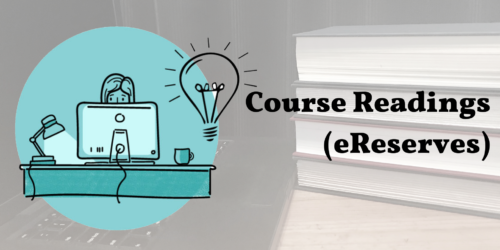Cognitive and Metacognitive Reading Strategies
Cognitive reading strategies help us to continue reading when complexity begins to impact comprehension. These types of strategies involve memory, attention, understanding new language, and problem-solving. They might look like memorizing new vocabulary, associating these with images, making contextual guesses about the meaning of some content, or sustaining reading attention. All of these can be impacted by digital reading, as devices pose distractions and we seek to conserve eye strain by reading quickly and superficially.

Metacognition is the act of thinking about how we think. When applied to reading, metacognitive strategies lead us to make deliberate choices about how we will approach reading a passage. Research indicates that learners are more likely to use meta cognitive strategies when reading online (Azmuddin, Nor, and Hamat, 2017). Further, an awareness of metacognitive habits improves cognitive reading and study habits (Khan & Rasheed, 2019).
Meta cognitive reading strategies help readers become more active critical interpreters of information. They extend and amplify learning from cognitive reading strategies. They also help us regulate and monitor our reading behaviours and stay on task, key challenges for digital readers (Ackerman & Lauterman, 2012; Lauterman & Ackerman, 2014).
Learners who can successfully combine cognitive and metacognitive reading strategies are more likely to become skillful learners (Khan & Rasheed, 2019, citing Dembo, 1994, and Javadi, Keyvanara, Yaghoobbi, Hassanzade, and Ebadi, 2010). However, they often do not have the skills yet to accomplish these independently. Decoding and processing new information, while simultaneously setting and referring to goals in reading, and managing one’s own reading behaviours, is a mark of an experienced learner. The following sections provide some information on evidence-based approaches supporting cognitive and meta cognitive reading strategies.
Activate Prior Knowledge
Before you start an engine, you prime it by pumping a little fuel into the engine. We need to do the same for our brains prior to learning. Further, we learn more easily when we can connect new information to old, and have a reference point from which to measure new learning.
To tap into what learners already know, create tasks that require students to brainstorm or concept map what they already know on a topic, or questions they may have about it. Some ideas for activating prior knowledge include brainstorms, concept maps, or graphic organizers.

Make sure learners keep this set of prior knowledge, and construct tasks that require they revisit these to check in with their learning progress.
Identify Questions or Gaps
Asking questions is a key way to learn, and setting out questions before reading is a meta cognitive habit that help establish purpose, which sustains attention and motivation. Before reading, create tasks that require learners to reflect on what they know, and set out a question they’d like an answer to. At the end of the reading, learners can self-check the question and reflect on whether they are now able to answer this.
After activating prior learning, ask learners to write 2-3 questions they have about the topic on a Padlet or sticky notes. Once submitted, organize these into similar questions. Refer to them through the unit, checking in to see if any are answered. Address any that remain.
Monitor Reading
Learners benefit both from repeated exposure to concepts, and from ongoing tracking and monitoring of their reading progress (Khan & Rasheed, 2019). Monitoring progress is often a challenge with digital texts, as there are no visible cues of progression, like accumulated tabs or sticky notes.
Consider incorporating a tracking mechanism like a reading guide, learning log or a QQC Journal to have learners practice monitoring their own reading. Find opportunities for learners to share this journal with peers for feedback, and encourage its submission as a marked component of your course. If the learning log incorporates a citation requirement, it can help develop valuable citation and referencing skills, alongside meta-cognitive and cognitive skills of tracking and revisiting information.
Re-Read Sections
Digital readers often read too quickly, and are over-confident in how well they’ve understood the content they’ve read (Ackerman & Goldsmith, 2011; Lauterman & Ackerman, 2014). If the text is informational, or if we perceive time constraints or that a reading selection is not important, then we are even more likely to read superficially (Sidi et al., 2017).
But by creating tasks that ask students to re-read selections, we improve the likelihood that they are reading deeply, and engaging with the text with meta cognitive processes. They have already had the chance to read through once, and a second pass helps to more deeply explore themes and determine importance. We can further improve this by making reading a collaborative and discussion based experience, where learners are expected to share insights with a group.
Try using a close reading activity to prompt learners to re-read a section. Select a portion of text that addresses an important concept. Create 3 to 5 guiding discussion questions, which should be open ended enough to support prolonged discussion. Provide time for learners to re-read that selection, and ask them to find a partner to discuss with.
Connect and Compare to other Texts
There is demonstrable value to asking students to consult a variety of resources. Students who use more online information sources compose better written work than those who rely on primary resources (Kiili and Leu, 2019). Evidence seems to support learning activities where learners must:
- Ascertain the validity of an online source of information, based on criteria like reliability, date of publication, author publication history, writing style, or other criteria;
- Compare two sources of research/information and evaluate the reliability or validity of each, recommending only one source to peers;
- If each source is equally credible, determine how the author framed the information to match their audience, effectively using style to communicate complex ideas.
Due to the sheer abundance and variety of content online, can often be an advantage to incorporate activities that ask learners to evaluate the reliability of a source for any researching or reading task.
Provide a brief news or journal article from the Library that offers either a complementary or opposing point of view or method. Offer time for them to re-read this in class. Prepare some questions to guide a discussion. Ask learners to compare these, using guiding questions to structure their discussion. At the end, ask learners to extend their learning by offering another perspective or method, or by making a choice about where they stand on the topic.
Practice Synthesis of Multiple Texts
Synthesizing information from multiple texts is a complex task, and one that requires referring to prior knowledge, identification of gaps, careful reading and re-reading, and strong connections and comparisons. We often ask learners to synthesize information, in the form of comparing two articles, creating a literature review or writing an essay. Before we ask learners to synthesize texts, especially digital texts, we need to make sure they have been scaffolded into the appropriate cognitive and meta-cognitive behaviours. These activities will help inform learners’ inferences and opinions as they develop their skills in independently synthesizing information (Barzilai and Stromso, 2018; Kiili and Leu, 2019 ). The activity of synthesis should be practiced in smaller, collaborative or cooperative contexts before it is expected independently.
If learners are compiling research or methods, encourage them to summarize different sources. Take these summaries and require them to be summarized into one sentence. This task is challenging, and requires deliberate thought to include and exclude information and be brief. It can be partnered well well with consistent use of a QQC Journal.
Explicit Instruction
The most successful way to result in learners’ use of metacognitive and cognitive learning strategies is through explicit instruction (Iwai, 2016). Prompt students into using strategies with statements like
Today, we’re going to try out a strategy that can help you monitor and track your own reading progress. Sometimes in a digital text, it is easy to become lost. This will help you see how far your learning has come, and gives you a strategy you can use in the future.”
Find out about additional lesson planning ideas you can use when teaching with digital texts. These tips were compiled by participants in Tech For Teaching workshops.
References
Ackerman, R. and Goldsmith, M. (2011). Metacognitive regulation of text learning: On screen versus on paper. Journal of Experimental Psychology: Applied, 17(1), pp. 18-32.
Azmuddin RA, Nor NFM, Hamat A. (2017). Metacognitive Online Reading and Navigational Strategies by Science and Technology University Students. GEMA Online Journal of Language Studies. 17(3):18-36. doi:10.17576/gema-2017-1703-02.
Barzilai, S., Strømsø, H.I. (2018). Individual differences in multiple document comprehension J. L. G. Braasch, I. Bråten, M.T. McCrudden (Eds.), Handbook of multiple source use, Routledge, New York, NY (2018), pp. 99-116.
Khan, M & Rasheed, S. (2019). Moderating Role of Learning Strategies Between Meta-Cognitive Awareness and Study Habits among University Students. Pakistan Journal of Psychological Research 34(1), 215-231. Retrieved from https://doi.org/10.33824/PJPR.2019.34.1.12.
Kiili C, Leu DJ. (2019). Exploring the collaborative synthesis of information during online reading. Computers in Human Behavior. 95:146-157. doi:10.1016/j.chb.2019.01.033.
Lauterman, T., and Ackerman, R. (2014). Overcoming screen inferiority in learning and calibration. Computers in Human Behavior, 35. 455-463. Retrieved from https://doi.org/10.1016/j.chb.2014.02.046.
Sidi, Y., Shpigelman, M., Zalmanov, H., Ackerman, R. (2017). Understanding metacognitive inferiority on screen by exposing cues for depth of processing. Learning and Instruction, 51 61-73 doi: 1016/j.learninstruc.2017.01.002
Iwai, Y. (2016). The Effect of Explicit Instruction on Strategic Reading in a Literacy Methods Course. International Journal of Teaching and Learning in Higher Education, 28(1), 110–118.



